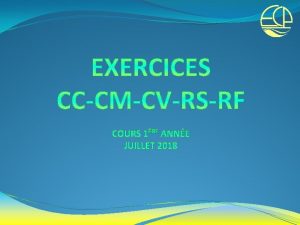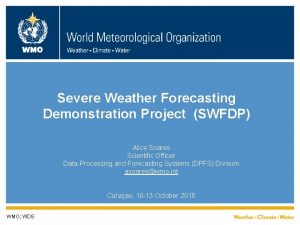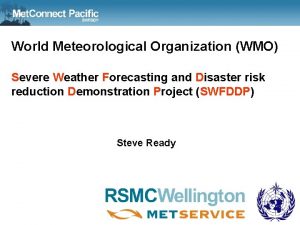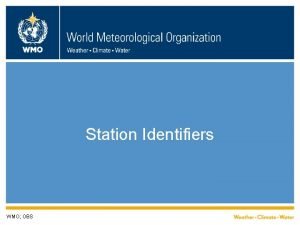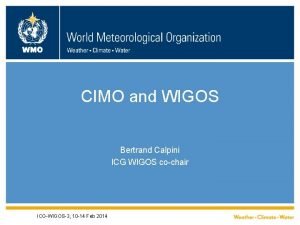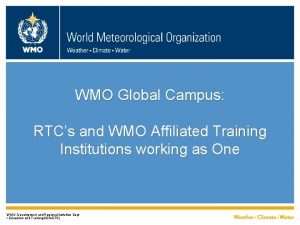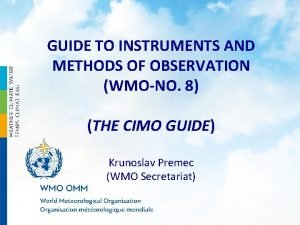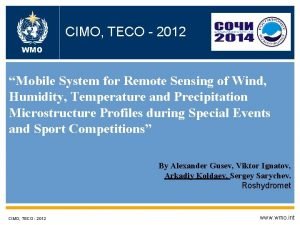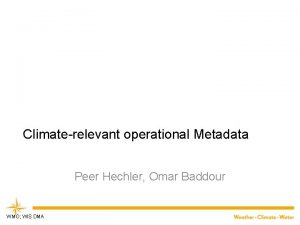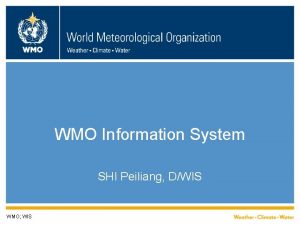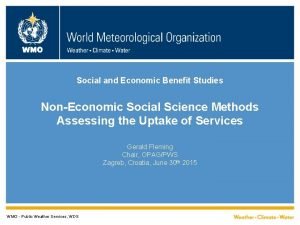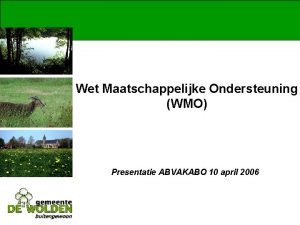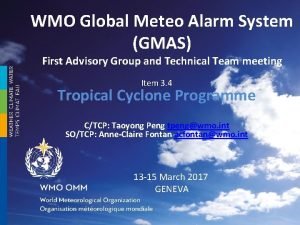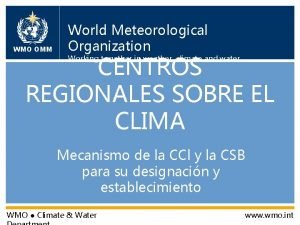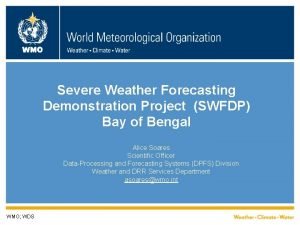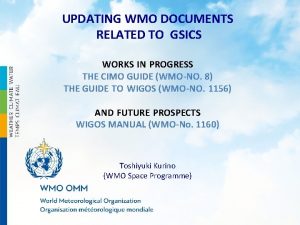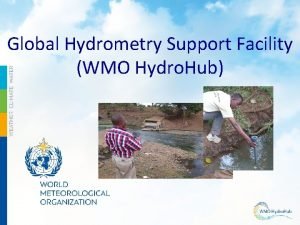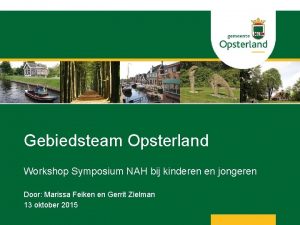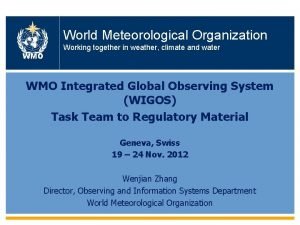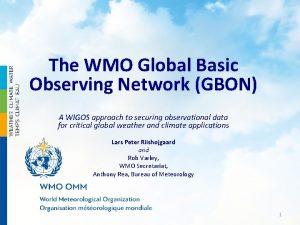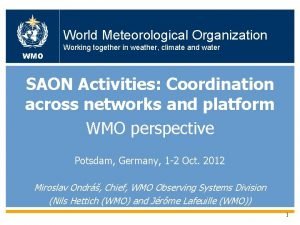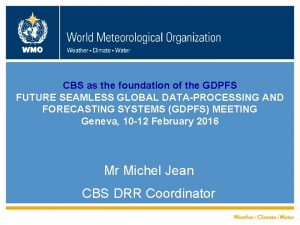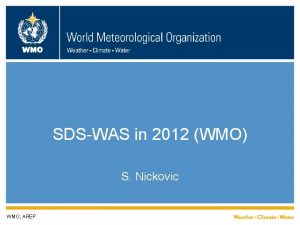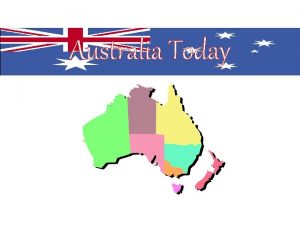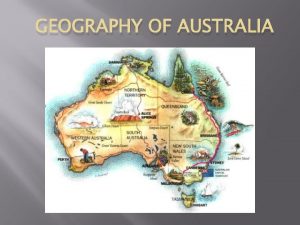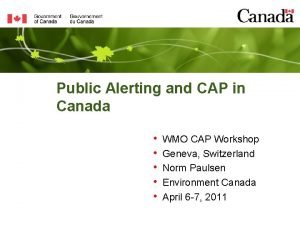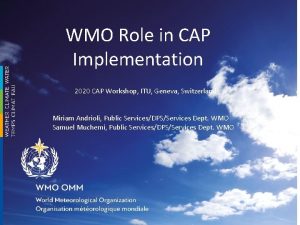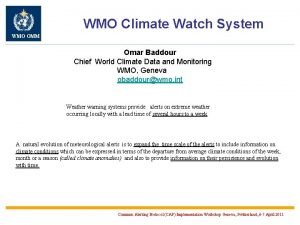CAP IN AUSTRALIA Presentation to the WMO CAP








































- Slides: 40

CAP IN AUSTRALIA Presentation to the WMO CAP Implementation Workshop 7 April 2011 Greg Trott Project Manager CAP-AP

Scope of this Presentation: • • Australia’s hazard environment CAP use in Australia CAP-AP: a standards approach Issues to resolve

• Australia’s hazard environment • CAP use in Australia • CAP-AP: a standards approach • Issues to resolve

Lat: 12. 5 S Long: 153 E 28 50 km 44 0 0 k m Long: 116 E 3600 km 18 00 km 2700 km 7. 7 mil sq km Lat: 43 S

How widespread is Australia? Population In 2010 was 22. 59 Million


Double Less than Average Triple


National Systems Approach to Community Warnings • To improve effectiveness of community advice and warnings • To contribute to community safety outcomes • Elements: – Preparing the community – Situational awareness – Message construction and dissemination – Appropriate action taken • All-hazards framework but focused on bushfires

Commonwealth Government • Support to the states and territories in developing capacity to deal with all-hazards • National coordination functions • Assistance when requested • Cost sharing arrangements for response and recovery expenditure

Any questions up to this point? • Australia’s hazard environment • CAP use in Australia • CAP-AP: a standards approach • Issues to resolve

CAP use in Australia • Catalyst: Royal Commission investigating bushfires in State of Victoria in February 2009. • Focus: enhancing the protection of human lives • Where: all states and territories use an alerting system that includes a CAP component • How: through various State-based Emergency Service organisations, including: – Fire, Rescue, Police, Health, Transport, Infrastructure

Intended method of operation • Information Officer generates a CAP message using approved templates • Message triggered through a single portal, which promotes consistency of content • Message appears concurrently on networked sites & sent to: – media broadcasters (to trigger use of SEWS); – Mobile telephones and other mobile devices; – RSS feeds

Attorney-General’s Department • Provides expert support to Government to maintain and improve Australia's system of: – law and justice – national security – emergency management. • AGD seeks to achieve three outcomes: – 1 - equitable / accessible system of federal civil justice. – 2 - Coordinated federal security and emergency management activity, for a safer Australia. – 3 - Assisting regions to manage their futures.

National Approach Collective efforts based on partnerships of the: • Commonwealth • States (6) • Territories (2) • local and regional governments • non-government organisations • industry • the community

Emergency Management Australia (EMA) • Commonwealth Agency responsible for coordinating the Australian Government response to emergency management. • Facilitates coordination through collaborative relationships with other Australian Government agencies: e. g. – Bureau of Meteorology (for Weather alerts) – Geoscience Australia (for earthquake / tsunami alerts) • Manages capability development programs

All-Hazards focus • All-hazards focus to any emergency – Prevent – Prepare for – Respond to – Recover from PPRR


Bureau of Meteorology: CAP Implementation • BOM warning products that will benefit from CAP: – Weather warnings • • • Tropical cyclone Coastal storm surge Severe thunderstorm and hail Marine winds Land winds Flash floods Fire weather Agricultural threats (like frost) etc – Riverine flood warnings* – Tsunami warnings#

Bureau of Meteorology: Timing of CAP Implementation • Nationwide implementation of the new Nex. Gen* weather forecast and warning preparation and dissemination system – Avoids need for costly adjustments to legacy systems • Finalisation of the CAP-AP standard. – BOM systems will aim to match CAP-AP standard – Saves need to conduct additional reviews of the software * System based on the US National Weather Service Graphical Forecast Editor

Bureau of Meteorology: CAP Implementation Likely timeline - CAP implementation in BOM: • Early 2012 – CAP-AP standard is defined/published (First Release)* • Late 2012 – CAP trial initiated for limited area (probably one state) • Late 2014 – CAP implemented for all warning products * This is outside the Bureau’s direct scope of responsibility

Where is CAP used in Australia? CAP Feed from July 2011 http: //www. ga. gov. au/earthquakes/

• Telephone warning system • Sends alerts to communities via: – landline telephones based on handset location – mobile phones based on registered service address http: //www. emergencyalert. gov. au/ © 2010, Commonwealth of Australia


Future Project Location based alerting capability • Federal Government funding • Capability to send warnings to mobile phones – based on the location of the handset • Separate negotiations required with each of the mobile carriers.



SEWS • A signal tone accompanied by: – spoken words Emergency, Emergency – that is sent via: • landline message • media broadcast (radio, TV etc) • SMS text message inlcudes word Emergency © 2010, Commonwealth of Australia

Alerting from Community-to-Government © 2010, Commonwealth of Australia

Any questions? • Australia’s hazard environment • CAP use in Australia • CAP-AP: a standards approach • Issues to resolve

Standards-based Approach • National Forums promote adoption of CAP • No common CAP standard in Australia • CAP-AP to be developed using a standardsbased approach: – Consensus approach that establishes common language and broadest acceptance by Users – Consultation with committees of technical experts and groups of interested stakeholders – Provides quality, trust and assurance to Users

Standards-based Approach (2) • Standards development pathways considered: – Commercial standards development organisations – Government’s National Standards Framework • NSF pathway selected due to: – Governance through Cross Jurisdictional CIO’s – Public consultation process was optional – No copyright issues imposed – No distribution restrictions imposed – Schedule and cost risks were lower

8 -Step NSF Process 1. 2. 3. 4. 5. 6. 7. 8. Project Proposal Project Authorisation Requirements Definition First Draft Review Compliance Review Implementation Verification Endorsement

• Australia’s hazard environment • CAP use in Australia • CAP-AP: a standards approach • Issues to resolve – Hazard Event Code interoperability matri. X (HECX) – HECX versus OID – HECX versus TSO

Australian Event Codes • AUSevent. REF list being developed to reflect hazard event names that are more recognisable to the Australian community • Intend to develop a Hazard Event Code interoperability matri. X (HECX)

Issue to resolve: HECX Challenge: How to assure correct interpretation of event codes from other countries Issue: Interoperability of event codes Intentions: – Consult with regional neighbours – Establish HECX between respective event code lists – Maintain regular update cycle (mutually agreed) – Provide the HECX information to CAP-AP Users

Issue to resolve: HECX v OID Challenge: Develop a methodology to map the CAP-AP HECX to an international event code list Issue: How could OID support HECX ? Australian HECX code North American event code Bushfire Wildfire / Forest Fire Tropical Cyclone Hurricane Sheep Grazier Warning ? Plant Pest ? Total Fire Ban ? Animal Plague ? Riverine Flood Overland Flow Flood Triple Zero 911 Service

Can see that CAP exists in OID scheme but… do not yet understand how the CAP-AP event codes can be mapped into the OID

Issue to resolve: HECX v TSO Challenge: Determine how the CAP-AP HECX can interoperate with the Tactical Situation Object (TSO) Issue: How can TSO support CAP-AP? Assessments to date: • Reviewed the 2006 document “Definition of the OASIS Tactical Situation Object” produced by the Open Advanced System for d. ISaster and emergency management (OASIS) • TSO Events are proposed to be mapped with CAP • TSO EVENT_TYPE can be used in the CAP event element

Questions ? AGD Point of Contact: Greg Trott Tel: +61 – 2 – 6141 3904 Gregory. Trott@ag. gov. au
 Cap compas
Cap compas Soft handicap
Soft handicap Wmo severe weather
Wmo severe weather Wmo severe weather
Wmo severe weather Wigos station identifier
Wigos station identifier Ipcc wmo
Ipcc wmo Wmo cimo
Wmo cimo Wmo global campus
Wmo global campus Gcw guide
Gcw guide Wmo
Wmo Alert hub
Alert hub Wmo-no. 8
Wmo-no. 8 Wmo cimo
Wmo cimo Omar baddour
Omar baddour Wmo wis
Wmo wis Wmo
Wmo Wmo country profile database
Wmo country profile database Ugly wmo
Ugly wmo Wmo omm
Wmo omm Wmo omm
Wmo omm Wmo radar database
Wmo radar database Wmo regional training centres
Wmo regional training centres Wmo
Wmo Gmas wmo
Gmas wmo Wmo strategic plan
Wmo strategic plan Wmo omm
Wmo omm Wmo bufr
Wmo bufr Wmo gts
Wmo gts Wmo
Wmo Ipcc wmo
Ipcc wmo Wmo 1150
Wmo 1150 Wmo gdpfs
Wmo gdpfs Cimo guide wmo
Cimo guide wmo Wmo hub
Wmo hub Gebiedsteam opsterland
Gebiedsteam opsterland Wmo
Wmo Wmo gbon
Wmo gbon Introduction and acknowledgement
Introduction and acknowledgement Wmo omm
Wmo omm Wmo regional training centres
Wmo regional training centres Wmo gdpfs
Wmo gdpfs
